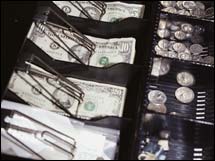Inflation tame as income, spending miss forecastsA key inflation measure falls into the Fed's comfort zone as core prices up less than 2 percent in last year.NEW YORK (CNNMoney.com) -- Consumers' spending and income improved a little less than expected in May, according to a government report Friday that also provided a favorable reading on a key inflation measure. Spending by individuals rose 0.5 percent in the month, the same as the rise in April. But economists surveyed by Briefing.com had forecast a 0.7 percent rise in spending. 
Much of the increase in spending was due to the record high gasoline prices in much of the month. Controlling for inflation, spending was up only 0.1 percent in May. "That is a very subdued rate of spending and it will limit the gain in [economic growth in] the second quarter," Kevin Logan, an economist at Dresdner Kleinwort Wasserstein in New York, told Reuters. Personal income was up 0.4 percent, better than the 0.2 percent decline in the revised April reading. But that too was below the forecast of 0.5 percent rise, and it did not keep up the rise in prices. Controlled for inflation, income actually slipped 0.1 percent in the month. But the report was still seen as good news by economists and investors because the so-called core PCE deflator, a closely watched inflation reading that measures the prices paid by individuals excluding food and energy, was up only 0.1 percent, in line with forecasts and the April gain. And that left the year-over-year rise in the core PCE at 1.9 percent. The fact it fell below the 2 percent benchmark was seen as significant since it is within what is believed to be the Federal Reserve's comfort zone of a 1 to 2 percent rise in that price measure. The overall PCE inflator, which includes food and energy prices, rose 0.5 percent in the month, up from 0.3 percent in April. The big jump in overall PCE was not a surprise given record high gas prices. The report is seen as further confirmation of the widely held belief that the Fed will leave interest rates unchanged going forward, as it did Thursday, and it even raised hopes that perhaps it could move toward a rate cut if there's sign of economic weakness. "If the economy softens more than expected the Fed would have the luxury to cut rates if they needed to," said Mark Vitner, senior economist with Wachovia. "But we don't think a cut is going to be needed, because spending should hold up reasonably well to keep the economy out of trouble." Stock futures rose immediately following the report, and stocks were higher in early trading. Treasury prices also rose, taking the yield to 5.08 from 5.1 percent late Thursday. The report also showed that for the 26th straight month, Americans spent more than they made in after-tax income, which once again resulted in a negative savings rate. The report shows the negative savings rate was 1.4 percent, up from the negative 1.2 percent a month early. That means of every $100 in after-tax income, Americans spent $101.40. An earlier version of this story had the wrong negative savings rate. CNNMoney.com regrets the error. |
Sponsors
|
